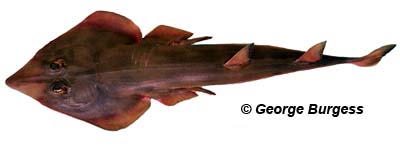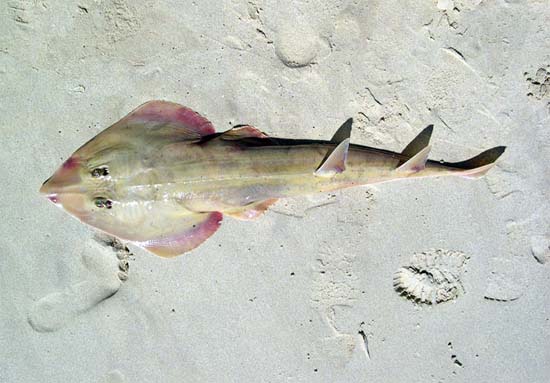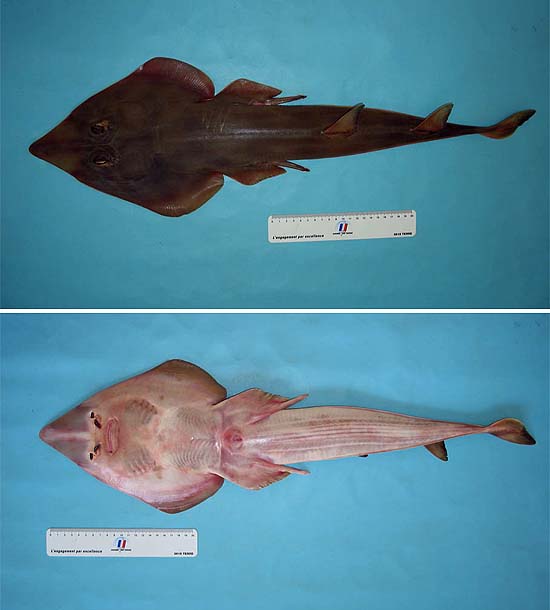Common Guitarfish

Rhinobatos rhinobatos
Guitarfish seem to be somewhere between sharks and rays, with an elongated tubular body and fins on the torso and tail, and a wide, flat pectoral disc at their head. This guitarfish grows to around 55 to 64 inches long, and is chocolate brown on top and white underneath, ideal camouflage for the muddy shallows and inshore areas it likes to hide in.
They generally lay in wait, partially covered in sand or mud, and ambush crustaceans and small fish by pinning them down with their long snouts and then sucking them into their mouths.
Order – Rajiformes
Family – Rhinobatidae
Genus – Rhinobatos
Species – rhinobatos
Common Names
English language common names are common guitarfish, common Mediterranean guitarfish, common violinfish, guitarfish, lengthened shape, and Mediterranean longnose. Other common names include almindelig guitarfisk (Danish), calascione (Italian), cassapai (Portuguese), catarre (Italian), chetarre (Italian), galascioene (Italian), geigenrochen (German), gemeiner geigenrochen (German), gewone gitaarrog (Dutch), glattrochen (German), guitare (French), guitarra (Portuguese/Spanish), guitarra común (Spanish), hairochen (German), kitararausku (Finnish), mandolino (Italian), manta (Spanish), mourr (Arabic), pesce chitarra (Italian), pesce violin (Italian), pesce viuline (Italian), pesciu chitara (Italian), peshk kitarë (Albanian), picudos (Spanish), pisci chitarra (Italian), pisci viulinu (Italian), poisson-guitare commun (French), quatra viulinu (Italian), rabeca (Portuguese), raia-tubarão (Portuguese), raie-guitare commune (French), rayón (Spanish), rebekkin (Maltese), rhinobate commun (French), rinovatos (Greek), rocha (Polish), squadre (Italian), squadru monicu (Italian), squotre (Italian), viola (Portuguese), viulinu (Italian), and vjolin (Maltese).
Importance to Humans
Guitarfish is caught in some regions of the Mediterranean Sea with gillnet, bottom set and drifting longlines. It is also taken as bycatch in bottom trawl fisheries. It is commonly marketed in Turkey for human consumption. Off the west coast of Africa, this species is taken as bycatch of the shrimp trawlers, bottom trawl cephalopod fisheries, and in artisanal gill net fisheries. The flesh is salted, dried, and exported throughout the region and the fins are sent to the Asian fin trade market.
Danger to Humans
The common guitarfish is considered harmless to humans.
Conservation
Although the common guitarfish is widely distributed, it is still subject to fishing pressures throughout most of its geographical range. Its coastal habitat preference makes it an easy target for subsistence fisheries as well as a common bycatch species in targeted fisheries. Populations are decreasing and even disappearing within some of the historical range of this species.
According to the International Union for Conservation of Nature and Natural Resources (IUCN), the common guitarfish is listed as “Endangered”. This status is based on past and suspected future declines of this species; the status of this species should be closely monitored. The IUCN consists of a global union of state, governmental agencies, and non-governmental organizations in partnership whose goal is to assess the conservation status of different species.
> Check the status of the common guitarfish at the IUCN website.
Geographical Distribution

The common guitarfish is found in the eastern Atlantic from the southern Bay of Biscay to Angola. It also occurs throughout the coasts of the Mediterranean Sea with a prevalence in the southern and eastern regions, in particular Gulf of Gabes on the East coast of Tunisia.
Habitat
Swimming slowly over or partially buried in sandy and muddy bottom substrates, the common guitarfish resides in waters from the intertidal zone to about 330 feet (100 m) in depth.
Biology

Distinctive Features
Guitarfish have the appearance of both a shark and a skate — their bodies are dorso-ventrally flattened like a skate or ray and the tail has two dorsal fins similar to most sharks. The pectoral fins are large and fused to the body, forming small ray-like wings. The rostral ridges are widely separated with slight convergence in the front. The anterior nasal lobe reaches to the level of the inner corner of the nostril and the posterior nasal flap is wide.
The spiracles each have two moderately developed folds with the outer one more prominent than the inner. Small thorns are present along the inner margin of the orbits, between the spiracles, on the shoulders and along the midline of the tail and disc. The tail is stout and appears as a continuation of the body. The two dorsal fins are located on the tail.
Coloration
The dorsal surface of the common guitarfish is brown and the underside is white.
Dentition
The common guitarfish have molariform teeth for crushing and grinding prey items.

Size, Age & Growth
The maximum reported length of the common guitarfish is 55 inches (140.0 cm) total length (TL) for males and 63.8 inches (162.0 cm) TL for females, however this species more commonly reaches lengths of 31.5 inches (80.0 cm) TL. Males reach maturity at 29.5 inches (75.0 cm) TL and females at 33.5 inches (85.0 cm) TL.
Food Habits
Juvenile common guitarfish feed primarily on crustaceans; adults prey on crustaceans and small fishes. In one study in the northeastern Mediterranean Sea, the main prey items found in stomachs were shrimp, fish, crabs, Squilla mantis and Crangon crangon. When capturing prey, guitarfish use the rostrum to pin their food source against the sea floor and use suction to bring the prey into the mouth.
Reproduction
The common guitarfish exhibits ovoviparity (also referred to as aplacental viviparity). The embryos feed initially on yolk and then get additional nutrition from the mother through absorption of uterine milk through specialized structures. Mating occurs during the summer months followed by a 9 month gestation period as documented in the Mediterranean. Each litter results in 4-10 pups with each pup measuring approximately 11.8 inches (30.0 cm) in length at birth.
Predators
It is likely that larger predatory fish sharing the same geographical location and habitat prey on the common guitarfish.
Parasites
An anisakid nematode Hysterothylacium aduncum has been documented in the spiral valves of the common guitarfish.
Taxonomy
The common guitarfish was originally described as Raja rhinobatos by Linnaeus in 1758 and later given the scientifically valid name of Rhinobatos rhinobatos. Synonyms referring to this species in past scientific literature include Rhinobatos rhinobatus Linnaeus 1758, Leiobatus panduratus Rafinesque 1810, Raia columnea Blainville 1816, Squatinoraja colonna Nardo 1824, Rhinobatus duhameli Blainville 1825, and Rhinobatus columnea Bonaparte 1836. The genus name comes from the Greek words “rhinos” meaning nose and “batis, -idos” meaning a ray.
Prepared by: Cathleen Bester